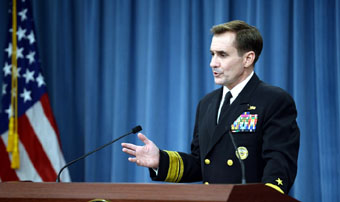
More U.S. Forces on the Way to Iraq
| published November 7, 2014 |
By R. Alan Clanton
Thursday Review editor
If you’re going to escalate military involvement in a faraway battle, the best time to raise those stakes is not right before an election. That’s why, both political and military analysts say, U.S. President Barack Obama waited until the Friday afternoon—three days after a major election—to announce exactly that: the United State will be deploying an additional 1500 personnel to support the current 1300 already inside Iraq.
On Friday the President authorized Secretary of Defense Chuck Hagel to send the additional forces as soon as possible. A statement by Pentagon Press Liaison Rear Admiral John Kirby said that the troops will serve in “a non-combat role,” but with the total number of American forces now approaching 3000, some military analysts suggest it is only a matter of time before U.S. personnel get involved in actual on-the-ground fighting.
A press release by the Department of Defense, made available to reporters on Friday, said that the President’s decision came after a request by the government of Iraq.
“U.S. Central Command will establish several sites across Iraq,” Kirby’s statement read, “that will accommodate the training of 12 Iraqi brigades, specifically nine Iraqi army and three Peshmerga brigades. These sites will be located in northern, western, and southern Iraq.” The press statement went on to add that members of other coalition forces will also be assisting in the training of the new brigades. The Pentagon’s goal: prepare Iraqi forces to face ISIS on the open battlefield. Though the battles lines near Baghdad have stabilized, ISIS positions are still within a mere 30 miles of the capital city. ISIS also continues its slow but inexorable progress in other parts of Iraq, consolidating its control over many of the areas it swept into over the summer.
In the meantime, fighting between ISIS forces and anti-ISIS forces in northern Syria and in parts of Iraq continue, even as the U.S. increases the number of sorties using fighter aircraft and heavy bombers. On Wednesday and Thursday U.S. forces successfully targeted specific members of the Khorasan Group, a terrorist cell—based in central Syria—which has drawn in members from at least a dozen countries. Most Khorasan members are hardened fighters or bomb-makers, and the target of Thursday’s attacks was believed by U.S. and British intelligence personnel to be a highly-skilled bomb-maker—one who authorities think had already developed and tested a powerful explosive device which could be easily hidden inside a working laptop or notebook computer.
The larger concern for the United States and the Iraqi government—as well as Kurdish fighters spread across several parts of northern Syria—is the continuing flow of volunteers for ISIS. U.S. intelligence expert and Pentagon officials believe that the current number of regular ISIS fighters is roughly 19,500 (some analysts, according to CNN, place the actual number at more than 31,000), but that number may be increasing each day as would-be militants and jihadists, from scores of countries in Europe and other places, make their way into Turkey, where they travel on foot or by small vehicle to the border with Syria. Despite some efforts by the government of Turkey to seal off the border near the major and minor checkpoints, analysts think that hundreds of jihadists from the United Kingdom, Denmark, France, Belgium, Spain and Germany (and some even from the United States and Canada) may be crossing the border along the hundreds of miles of demarcation separated only by a six foot fence. The border along some parts of Turkey and northern Iraq is even more porous in places than the border with Syria.
Turkey has instituted a sweeping program to improve both border security and law enforcement operations in airports, train stations, subway stations and bus terminals. But Interpol now says that because of Turkish efforts to stanch the flow, would-be militants are using cruise ships and passenger ferry boats to enter Turkey in large numbers. Once on Turkish soil, the potential jihadists then simply walk, hitchhike or ride buses toward areas near the Syrian or Iraqi borders.
The Turkish government says that its intensive operations have produced results—catching would-be jihadists at airports, bus stations and train stations—but now, the Turks say, they will have to deploy many hundreds of additional, highly-trained personnel to monitor those disembarking from cruise ships, passenger ferries, and perhaps even smaller boats. Interpol says it has evidence that hundreds have already used passenger ships to make their way into Turkey.
According to press reports, some captured ISIS fighters have revealed to interrogators that ISIS is now made up of fighters from more than 60 countries from nearly every part of the world. More striking is the fact that as many as half of the militants who make up ISIS may be from nations outside of Syria or Iraq. Many other members of ISIS were—until very recently—prisoners in jails in Iraq or Syria. Once freed by ISIS militants, they were given the option to join the jihadist crusade or face punishment or death.
Though the Pentagon and the White House have stressed that the U.S. troops currently in Iraq are in rear positions and will be there only for training and advisory purposes, many military analysts—including some retired military—suggest that there is no such thing as a non-combat role in scenarios like the one the U.S. faces in Iraq, and eventually American troops will have to engage in combat, even if it is for self-defense. In Washington, and in some media circles, there is a growing sense that this is history repeating itself. CNN’s Jake Tapper said today “we’ve seen this movie before.”
Related Thursday Review articles:
ISIS, the Kurds, & the Fight for Kobani; R. Alan Clanton; Thursday Review; October 20, 2014.
Does ISIS Have Air Power Ambitions?; R. Alan Clanton; Thursday Review; October 17, 2014.
